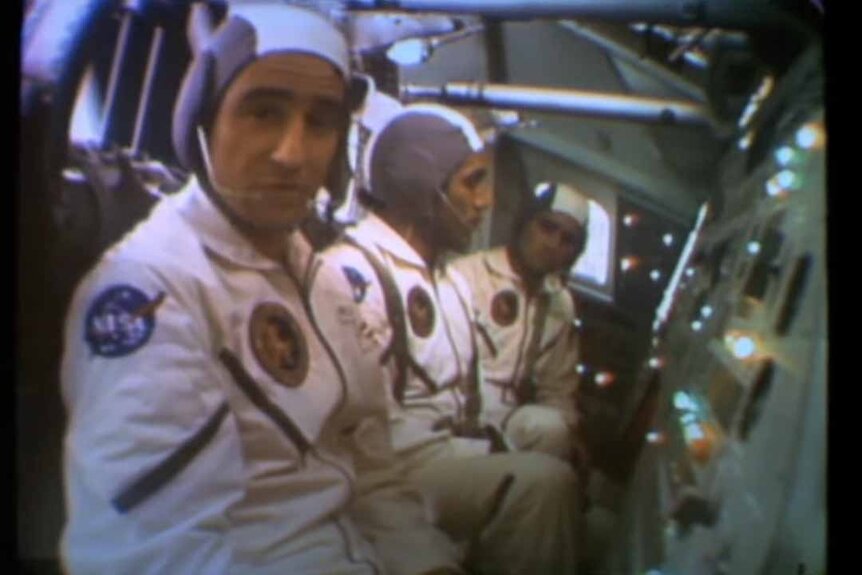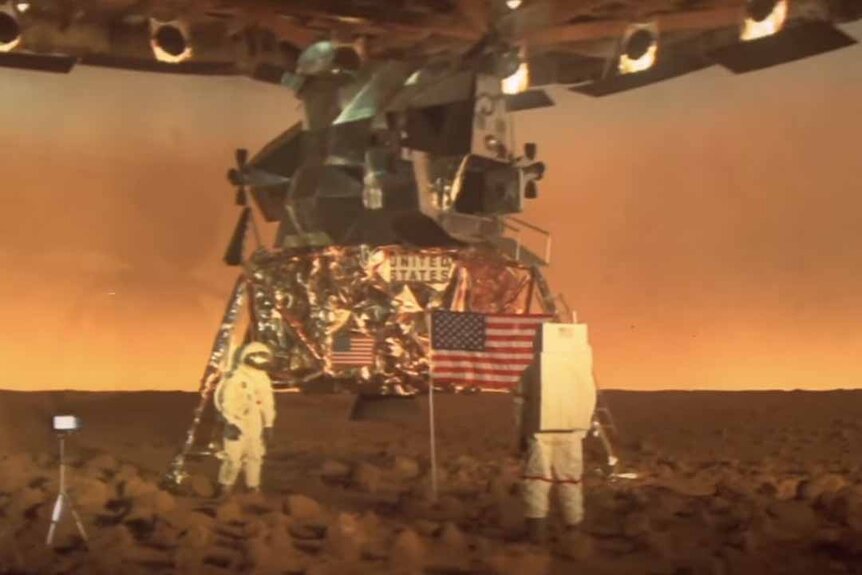Create a free profile to get unlimited access to exclusive videos, sweepstakes, and more!
Could You Really Fake a Mars Landing? The Science of Capricorn One
You could try!
The early days of human space exploration brought a mixture of excitement and trepidation. The world’s first artificial satellite, the Soviet Union’s Sputnik, dragged a trail of panic in its wake as it circled the globe and triggered a technological contest to put boots on the Moon. The 12 years between Sputnik and Apollo 11 were driven in large part by unparalleled public support. When Neil Armstrong and Buzz Aldrin stepped out of the Lunar Module and onto the lunar surface in 1969, an estimated 650 million people (that’s roughly one fifth of the total global population at the time) were watching around the world.
By the time Apollo 17 came around a few years later, public support had softened. “While most observers agree on the importance of the Moon explorations, for science and for history, the fact is that pictures, no matter how incredibly good their technical quality, of baren [sic] Moon scapes and floating astronauts become ordinary and even tedious rather quickly,” wrote reporter John J. O’Connor, at the time.
RELATED: Meet the Artemis II Astronauts, Set to Take NASA's Historic 2024 Return Trip Around the Moon
Meanwhile, another reporter, CBS’ Peter Hyams, had been covering the Apollo program and was thinking about how those same pictures and videos might be even more exciting than they seem. The evolution of moving picture technology occurring around the same time as the space race sparked an idea in Hyams’ mind, an idea which is now commonplace but was pretty novel at the time: What if the Moon landings had been faked? “There was one event of really enormous importance that had almost no witnesses. And the only verification we have… came from a TV camera,” Hyams said, via the book Spacesuit: Fashioning Apollo.
The combination of those two ideas – emerging visual technologies and dwindling public interest in Moon landings – germinated a story in Hyams’ mind which would eventually become the 1977 film Capricorn One, (streaming now on Peacock), which examines what it might be like to stage a fake mission to Mars.
Peter Hyams’ Underappreciated 1977 Space Caper Capricorn One
We enter the world of Capricorn One on launch day. Astronauts Charles Brubaker (James Brolin), Peter Willis (Sam Waterson), and John Walker (O.J. Simpson) enter a spacecraft headed for the Red Planet. They are strapped in and ready to go with less than a minute left in the countdown when a man in a suit and tie opens the hatch and pulls them out.
They hop a bus, then a helicopter, then an airplane, and end up at a small facility a few hundred miles away. Meanwhile, everyone at Mission Control believes they are still aboard and the launch continues apace. The Capricorn One spacecraft lifts off from Cape Canaveral with no one inside. Understandably confused, the crew of Capricorn One are greeted by their good friend and mission lead, Dr. James Kelloway (Hal Holbrook), who lets them in on what’s going on.
RELATED: Video of Mars helicopter Ingenuity's 25th flight
The public doesn’t care anymore. Almost no one showed up to the launch, and Congress is looking for any excuse to shut down the program. Kelloway received a call from the President himself saying that a single screw up would be the end of crewed exploration. That’s all fine as long as Capricorn One goes off without a hitch, the only trouble is the life support system doesn’t work and the crew would be dead within weeks. There isn’t time to fix it so Kelloway hatches a plan to save the future of human space exploration and his own neck. He just has to fake the mission, and the crew have to help.
Why a Faked Mars Mission Would Never Work
Kelloway does some pretty clever things to give his conspiracy the best shot at success. The secret to any good caper is keeping it small and he pulled that off by waiting until the last moment to remove the crew. Only Kelloway and a small group of supporters know what’s going on. Mission Control is monitoring the actual flight (empty as it might be) and Kelloway pre-recorded crew responses during training and is transmitting those recordings from the ship’s command module.
The last-minute switcheroo narrowly sidesteps one of the most common complaints regarding a Moon (or Mars) landing conspiracy. Faking Apollo 11 would have required thousands of people all working together and all collectively deciding to maintain the lie, not just then, but for the rest of their lives.
Kelloway’s method avoids all that by actually doing the mission and just not sending any people. Assuming you can make the launch happen and you’ve got the people and the know-how to shoot convincing footage of the Martian surface, you’d still have some pretty significant hurdles to overcome. And the comparatively low gravity of Mars won’t help you clear them.
You’re going to have to deal with light-speed lag. Because light moves through space-time at a fixed rate, transmission times between the Earth and a moving spacecraft would grow as the craft moved farther away. The time it takes for light to travel between Earth and Mars varies, depending on where each of the planets are in their orbit, so by the time the crew of Capricorn One reached the Red Planet, the light-speed travel time could be as much as 22 minutes. That means that any message we send would take 22 minutes to get there and any response would take 22 minutes to get back. Any fake transmissions you shoot and broadcast would need to take that into account. If your Mars footage shows up too early, someone’s going to figure it out immediately.
Assuming you time your transmissions right and avoid suspicion, you’re still going to have to deal with unmatched scrutiny. The world of today is not the world of 1969 or of 1977. If you broadcast doctored footage in the year of our Gorn 2023, a 9-year-old with an iPhone will figure it out before bedtime and blast you all over TikTok to her inexplicable 12-million-people following. And if that enterprising 9-year-old doesn’t out you, some other space agency will.
RELATED: See Mars’ Jezero Crater for yourself in this stunning video tour
To date, 18 spacecraft have operated in orbit around Mars and seven of them are still active. NASA has three, the 2001 Mars Odyssey orbiter, the Mars Reconnaissance Orbiter (MRO), and MAVEN. The other four – Mars Express, the ExoMars Trace Gas Orbiter, the Hope orbiter, and Tianwen 1 – are controlled and operated by the ESA (various European nations), Roscosmos (Russia), UAESA (United Arab Emirates), and CNSA (China).
In the movie, Kelloway is masterminding the whole thing. NASA doesn’t know, not even the president knows. So, the first threat to the whole enterprise would be from NASA itself. Mars Odyssey and MAVEN are both capable of imaging the ground, but the MRO is purpose-built for the job. Everything would be fine with your empty spacecraft and pre-recorded messages until it touched down on Mars and no one stepped out. The footage you shot on a remote soundstage might placate people for a little while, until the folks at NASA start asking why they’re not seeing what you’re seeing.
Then again, maybe NASA doesn’t want to be embarrassed on the world stage. Maybe we can assume they’ll cross their fingers and go for the ride, but there’s no reason to think the rest of the world will do the same. ExoMars is a joint project between the ESA and Roscosmos. Getting them to not tell the world what we’re doing would mean convincing the ESA’s 22 member states and Russia to play along.
Then there is Tianwen 1, which has a resolution of at least 7 meters. That’s not amazing, you wouldn’t be able to resolve two different astronauts standing next to one another or see precisely what they are doing, but you wouldn’t need to. That’s plenty of resolution to know whether or not there are actually people and machines on the surface of the planet, moving around and doing things. Any surface operations on Mars would change the surface of the planet enough that one or more of these orbiting spacecrafts would be able to tell.
Faking a Mars mission would require the cooperation of space agencies, engineers, and scientists all over the world. At a certain point, you have to ask yourself who the ruse is even for.
Besides, it would never work. See for yourself in Capricorn One, streaming now on Peacock.
































